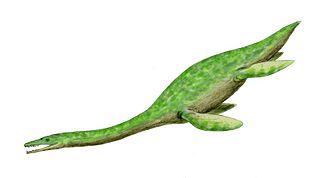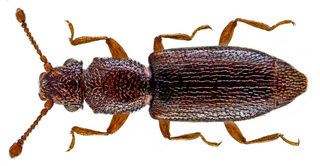
The eastern long-necked turtle is an east Australian species of snake-necked turtle that inhabits a wide variety of water bodies and is an opportunistic feeder. It is a side-necked turtle (Pleurodire), meaning that it bends its head sideways into its shell rather than pulling it directly back.

Thililua is a genus of polycotylid plesiosaur, containing one species, T. longicollis. The name Thililua is derived from that of an ancient aquatic god from local Berber mythology; longicollis refers to the animal's long neck. Thililua has been found in Late Cretaceous rocks in the High Atlas mountains of Morocco in north Africa. Thililua is the first Polycotylid plesiosaur discovered in Africa, and also the first discovered that lived at a subtropical latitude. In 2010, Thililua was transferred to Leptocleididae as a sister taxon to Nichollssaura.

Dolichosaurus is an extinct genus of marine squamate of the Upper Cretaceous Cenomanian chalk deposits of England. Sister-group relationships between coniasaurs, dolichosaurs, Aigialosauridae and Mosasauridae are an unresolved polytomy. The paleobiology of Dolichosaurus is reconstructed as similar to coniasaurs, nothosaurs, and modern sea snakes.
Babiana longicollis is a species of plant in the Iridaceae family. It is endemic to Namibia.
Chelodina steindachneri, commonly known as the dinner-plate turtle or Steindachner's turtle, is a species of turtle in the family Chelidae. The species is the least known of the Australian turtles and also one of the smallest members of the long-necked turtles of the genus Chelodina. It is a member of the subgenus Chelodina making it closely related to the Chelodina longicollis group of species.
Calathus longicollis is a species of ground beetle from the Platyninae subfamily that can be found in Bulgaria, Greece, Russia, Armenia, Cyprus, Georgia, Israel, Lebanon and Turkey.

Sybra is a genus of beetles in the family Cerambycidae, containing the following species:

Sybra umbratica is a species of beetle in the family Cerambycidae. It was described by Pascoe in 1865.
Sybra bioculata is a species of beetle in the family Cerambycidae. It was described by Pic in 1925. It contains four subspecies: Sybra bioculata bioculata, Sybra bioculata quadrinotata, Sybra bioculata sikkimana, and Sybra bioculata tigrina.

Sybra ordinata is a species of beetle in the family Cerambycidae. It was described by Bates in 1873.
Sybra pascoei is a species of beetle in the family Cerambycidae. It was described by Lameere in 1893.
Gnoma longicollis is a species of beetle in the family Cerambycidae. It was described by Johan Christian Fabricius in 1787 originally under the genus Cerambyx. It is known from Malaysia, Borneo, Singapore, India and Sumatra.
Acalolepta longicollis is a species of beetle in the family Cerambycidae. It was described by E. Forrest Gilmour in 1956. It is known from Nepal.
Cardiocephaloides longicollis is a species of flukes. The life cycle of C. longicollis is asexual as well as complex. Its asexual stage resides in the body of whelks where it replicates many times, and eventually its eggs are dispersed in the water through feces. C.longicollis begin their early life as free swimming miracidia larvae in the water. They go on to infect snails, and a variety of fishes, usually second intermediate host, in the form of a cercariae. While C.longicollis has previously been recorded in 19 fish species, researchers have found 12 other species which are viable hosts for C.longicollis making for a grand total of 31 aquatic species. The final host for this parasite are the gulls that eat the infected fish in which the parasite has formed cysts in.
Spirobolus longicollis, is a species of round-backed millipede in the family Spirobolidae. It is endemic to Sri Lanka.
Neoserixia longicollis is a species of beetle in the family Cerambycidae. It was described by Gressitt in 1935.
Charybdis longicollis, the lesser swimming crab, is a species of crab from the swimming crab family, the Portunidae. It has a native range which covers the north-western Indian Ocean and it has been invaded the Mediterranean Sea by Lessepsian migration through the Suez Canal.
Lomamyia longicollis is a species of beaded lacewing in the family Berothidae. It is found in North America.

Monotoma longicollis is a species of root-eating beetle in the family Monotomidae. It is found in Africa, Australia, Europe & Northern Asia, North America, and Southern Asia.








